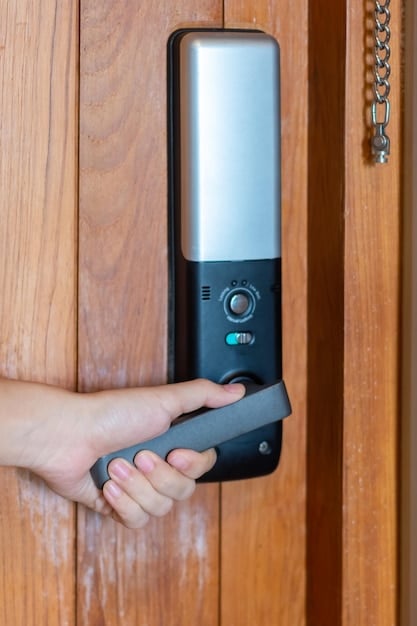Smart Home Security System 2025: Choose the Right One

Choosing the right smart home security system in 2025 involves considering factors like integration with existing smart devices, advanced AI capabilities, comprehensive monitoring services, and robust data privacy measures to ensure your family’s safety and peace of mind.
Securing your home is paramount, and in 2025, a smart home security system: how to choose the right one for your family’s needs in 2025 is no longer a luxury but a necessity. Let’s dive into the key considerations for selecting the perfect system.
Understanding the Evolving Landscape of Smart Home Security
The smart home security market is constantly evolving. In 2025, we can expect even more advanced features, greater integration capabilities, and a stronger emphasis on user privacy. Understanding these trends is the first step in making an informed decision.
The options are vast and varied, ranging from simple DIY kits to professionally installed and monitored systems. Each offers a different level of protection, convenience, and cost. To effectively navigate these choices, let’s explore the key components and features that define a modern smart home security system.
Key Components of a Smart Home Security System
A robust smart home security system typically consists of several key components working together to protect your home and family.
- Control Panel: The central hub that connects all devices and allows you to manage your system.
- Door and Window Sensors: These detect when a door or window is opened, triggering an alarm if the system is armed.
- Motion Detectors: These sensors detect movement within a specific area and are useful for identifying intruders.
- Security Cameras: Offering both indoor and outdoor surveillance, cameras provide visual verification of events.
- Smart Locks: Allow for keyless entry and remote locking/unlocking of doors.
- Sirens: Alert you and your neighbors.

Advanced Features to Consider
Beyond the basic components, modern systems often include advanced features that enhance their effectiveness and convenience.
- Facial Recognition: The system can identify authorized individuals and prevent false alarms.
- Two-Way Audio: Allows you to communicate with visitors or potential intruders through the camera.
- Professional Monitoring: A monitoring center provides 24/7 surveillance and dispatches emergency services when needed.
- Mobile App Control: Manage your system remotely from your smartphone or tablet.
Choosing the right system means considering these components and whether they align with your specific needs and preferences. Prioritizing features like professional monitoring or advanced AI can significantly impact your overall security.
Evaluating Your Family’s Specific Security Needs
Before diving into the specifics of different systems, it’s crucial to evaluate your family’s unique security needs. What works for one household may not be the best fit for another. Factors such as the size of your home, its location, and your lifestyle all play a role.
Begin by assessing potential vulnerabilities and areas of concern. This will help you prioritize the features and components that are most important for your particular situation. Don’t overspend on unnecessary features; instead, focus on creating a security system that addresses your specific risks.
Assessing Your Home’s Vulnerabilities
Consider the following questions:
- Are there multiple entry points that need to be secured?
- Is your home located in an area with a high crime rate?
- Do you have valuables that require extra protection?
Determining Your Monitoring Needs
Decide whether you prefer self-monitoring or professional monitoring. Self-monitoring offers cost savings but requires you to be vigilant and responsive. Professional monitoring provides peace of mind but comes with a monthly fee.
- Are you comfortable responding to alerts and contacting emergency services yourself?
- Do you need 24/7 monitoring coverage, even when you’re away?
Evaluating your home’s vulnerabilities and evaluating your monitoring needs are the basis to establish your family’s specific security needs and preferences. Ultimately, the best system is one that aligns with your budget, comfort level, and security goals.
Key Features to Look for in a 2025 Smart Home Security System
In 2025, several key features will differentiate the best smart home security systems from the rest. These features leverage advancements in AI, IoT, and cloud technology to provide more effective and intuitive security solutions.
Pay close attention to these features when evaluating different systems, as they will have a big impact on your security, convenience, and overall satisfaction. Advanced AI integration or enhanced privacy are some specific features to keep an eye on.
Advanced AI Integration
AI is transforming the smart home security landscape, enabling systems to learn, adapt, and respond more intelligently to potential threats.
- Behavior Analysis: AI can analyze patterns of activity and identify suspicious behavior.
- Object Recognition: AI can differentiate between people, animals, and vehicles, reducing false alarms.
- Predictive Security: AI can anticipate potential threats based on historical data and external factors.
Enhanced Data Privacy and Security
With increasing concerns about data privacy, it’s essential to choose a system that prioritizes the security of your personal information.
- End-to-End Encryption: Ensures that your data is protected from unauthorized access.
- Two-Factor Authentication: Adds an extra layer of security to your account.
- Transparent Privacy Policies: Provides clear information about how your data is collected and used.
Looking for these key features in a smart home security system will guarantee it’s advanced AI capabilities and that you will have an enhances data privacy.

Comparing Top Smart Home Security Systems of 2025
With numerous options available, comparing the top smart home security systems of 2025 can feel overwhelming. To simplify the process, let’s take a look at some of the leading contenders and evaluate their strengths and weaknesses like ADT Smart Home
We’ll also consider factors such as pricing, features, ease of installation, and customer support. Understanding these pros and cons will help you narrow down your choices and identify the systems that best fit your needs.
ADT Smart Home
ADT has been a trusted name in home security for decades, is integrating traditional security with smart home technology. Offering professional installation and monitoring services, ADT provides comprehensive protection.
- Pros: Professional installation and monitoring, wide range of features, reputable brand.
- Cons: Higher upfront and monthly costs, long-term contracts.
SimpliSafe
SimpliSafe is a popular DIY option that offers affordable security without long-term contracts. The system is easy to install and provides reliable protection.
- Pros: Affordable, easy to install, no long-term contracts.
- Cons: Limited smart home integration, basic features.
Ring Alarm
Ring Alarm, from Amazon, offers a cost-effective and versatile solution with tight integration with other Ring devices and Alexa.
- Pros: Affordable, easy to install, integrates with Ring devices and Alexa.
- Cons: Limited professional monitoring options, some privacy concerns.
Comparing the top smart home security systems of 2025, we can find the best feature for you and the most reliable system.
Installation and Setup: DIY vs. Professional Options
One of the key decisions you’ll need to make is whether to install your smart home security system yourself or opt for professional installation. Both options have their advantages and disadvantages, depending on your technical skills, budget, and time constraints.
DIY installation can save you money on installation fees, but it requires time, effort, and technical expertise. Professional installation ensures that your system is set up correctly and optimized for your home, but it comes with additional costs.
DIY Installation
DIY options are becoming increasingly popular due to their affordability and ease of use. These systems typically come with pre-configured devices and simple installation instructions.
- Advantages: Cost savings, flexibility, sense of accomplishment.
- Disadvantages: Time-consuming, requires technical skills, potential for errors.
Professional Installation
Professional installation involves hiring a qualified technician to install and configure your system. This ensures that all components are properly connected and optimized for your home.
- Advantages: Expertise, convenience, peace of mind.
- Disadvantages: Higher cost, scheduling constraints, less control over the process.
The installation and setup, weather is DIY or professional will affect what you get overall in quality, money or time.
Maintaining and Upgrading Your Smart Home Security System for the Long Term
Once you’ve installed your smart home security system, it’s important to maintain it properly and upgrade it regularly to ensure its continued effectiveness. Technology evolves rapidly, and new threats emerge constantly.
Regular maintenance, software updates, and proactive upgrades are crucial for keeping your system up-to-date and secure. This also means staying informed about the latest security threats and best practices, and adjusting your system accordingly.
Regular Maintenance
Regular maintenance involves checking the functionality of all components, replacing batteries, and cleaning sensors and cameras.
- Test all sensors and cameras regularly.
- Replace batteries in sensors and keypads as needed.
- Clean cameras and sensors to ensure clear visibility and accurate readings.
Software Updates and Upgrades
Software updates and upgrades provide new features, security patches, and performance improvements.
- Enable automatic software updates to ensure that your system is always up-to-date.
- Consider upgrading to newer models of devices as technology advances.
With regular maintenance and software upgrades, your smart home security system for the long term is guaranteed.
| Key Aspect | Brief Description |
|---|---|
| 🏠 Home Evaluation | Assess your home’s vulnerabilities like entry points and location. |
| 🤖 AI Integration | Look for AI-driven features like behavior analysis and object recognition. |
| 🔒 Data Privacy | Ensure end-to-end encryption and transparent privacy policies. |
| 🛠️ Installation Type | Choose between DIY and professional installation based on your skills. |
Frequently Asked Questions (FAQ)
▼
Key components include a control panel, door/window sensors, motion detectors, security cameras, and smart locks, all working together to protect your home.
▼
AI-powered systems offer advanced features like behavior analysis, object recognition, and predictive security, which reduce false alarms and improve threat detection.
▼
Look for systems with end-to-end encryption, two-factor authentication, and transparent privacy policies to ensure your personal information is protected.
▼
DIY is cost-effective but requires technical skills, while professional installation ensures proper setup and expertise, although at a higher cost.
▼
Regularly test components, replace batteries, keep the app updated, and consider upgrading devices as technology advances to maintain optimal security.
Conclusion
Choosing the right smart home security system: how to choose the right one for your family’s needs in 2025 requires careful consideration of your family’s needs, the system’s features, and your comfort level with installation and maintenance. By staying informed and proactive, you can create a secure and protected home environment.





